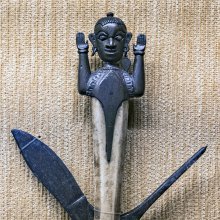Kathi, Kāṭhī: 12 definitions
Introduction:
Kathi means something in Hinduism, Sanskrit, the history of ancient India, Marathi, Hindi, biology. If you want to know the exact meaning, history, etymology or English translation of this term then check out the descriptions on this page. Add your comment or reference to a book if you want to contribute to this summary article.
Images (photo gallery)
In Hinduism
Shilpashastra (iconography)
Source: Shodhganga: The significance of the mūla-beras (śilpa)Kathi or Surikai refers to one of the several “attributes” (āyudha) or “accessories” of a detiy commonly seen depicted in Hindu iconography, defined according to texts dealing with śilpa (arts and crafs), known as śilpaśāstras.—Kathi is a short knife. It is also called as surikai.

Shilpashastra (शिल्पशास्त्र, śilpaśāstra) represents the ancient Indian science (shastra) of creative arts (shilpa) such as sculpture, iconography and painting. Closely related to Vastushastra (architecture), they often share the same literature.
Natyashastra (theatrics and dramaturgy)
Source: Shodhganga: Elements of Art and Architecture in the Trtiyakhanda of the Visnudharmottarapurana (natya)Kathi refers to one of the traditional Facial Masks in the Kutiyattam type of theater of Kerala.—The facial make-over of the characters of Kūṭiyaṭṭam and Kathakalī has been categorised according to the taste of an individual actor and the school of tradition to which it belongs.—The term kathi that literary means knife is so called because the shapes of colour positions resemble here a bent and sharp kukri (dagger).

Natyashastra (नाट्यशास्त्र, nāṭyaśāstra) refers to both the ancient Indian tradition (shastra) of performing arts, (natya—theatrics, drama, dance, music), as well as the name of a Sanskrit work dealing with these subjects. It also teaches the rules for composing Dramatic plays (nataka), construction and performance of Theater, and Poetic works (kavya).
India history and geography
Source: Shodhganga: A translation of Jhaverchand Meghanis non translated folk talesKathi refers to “A caste of Rajput is known as Kathi. As they are physically strong they are known as Kathi”.—It is defined in the glossary attached to the study dealing with Gujarat Folk tales composed by Gujarati poet Jhaverchand Meghani (1896-1947)
Source: Shodhganga: Vernacular architecture of Assam with special reference to Brahmaputra Valley1) Kathi is an Assamese term referring to “bamboo splint”.—It appears in the study dealing with the vernacular architecture (local building construction) of Assam whose rich tradition is backed by the numerous communities and traditional cultures.
2) Kathi is also an Assamese term referring to “eaves / veranda”.

The history of India traces the identification of countries, villages, towns and other regions of India, as well as mythology, zoology, royal dynasties, rulers, tribes, local festivities and traditions and regional languages. Ancient India enjoyed religious freedom and encourages the path of Dharma, a concept common to Buddhism, Hinduism, and Jainism.
Biology (plants and animals)
Source: Wisdom Library: Local Names of Plants and DrugsKathi [काथी] in the Hindi language is the name of a plant identified with Indigofera cassioides Rottler ex DC. from the Fabaceae (Pea) family having the following synonyms: Indigofera pulchella, Indigofera leptostachya. For the possible medicinal usage of kathi, you can check this page for potential sources and references, although be aware that any some or none of the side-effects may not be mentioned here, wether they be harmful or beneficial to health.
Kathi [काथी] in the Hindi language is the name of a plant identified with Indigofera heterantha Wall. ex Brandis from the Fabaceae (Pea) family.
Kathi in the Hindi language is the name of a plant identified with Indigofera trifoliata L. from the Fabaceae (Pea) family having the following synonyms: Indigofera moluccana, Indigofera barberi, Indigofera vestita.
Source: Google Books: CRC World Dictionary (Regional names)1) Kathi in India is the name of a plant defined with Desmodium elegans in various botanical sources. This page contains potential references in Ayurveda, modern medicine, and other folk traditions or local practices It has the synonym Hedysarum tiliaefolium D. Don (among others).
2) Kathi is also identified with Indigofera cassioides It has the synonym Anila pulchella (Roxb.) Kuntze (etc.).
3) Kathi is also identified with Indigofera hebepetala It has the synonym Indigofera hebepetala Benth. ex Baker (etc.).
4) Kathi is also identified with Indigofera heterantha It has the synonym Indigofera gerardiana Wall. ex Baker (etc.).
5) Kathi is also identified with Indigofera trifoliata It has the synonym Indigofera multicaulis DC. (etc.).
6) Kathi is also identified with Sophora mollis It has the synonym Edwardsia hortensis Boiss. & Buhse (etc.).
Example references for further research on medicinal uses or toxicity (see latin names for full list):
· Nomenclator Botanicus. (1840)
· Hooker’s Journal of Botany and Kew Garden Miscellany (1852)
· Proc. 3rd All Indian Congr. Cytol. Genet. (1981)
· The Flora of British India (1876)
· A Numerical List of Dried Specimens (5480)
· Plantae Delavayanae (1889)
If you are looking for specific details regarding Kathi, for example extract dosage, health benefits, pregnancy safety, side effects, chemical composition, diet and recipes, have a look at these references.

This sections includes definitions from the five kingdoms of living things: Animals, Plants, Fungi, Protists and Monera. It will include both the official binomial nomenclature (scientific names usually in Latin) as well as regional spellings and variants.
Languages of India and abroad
Marathi-English dictionary
Source: DDSA: The Molesworth Marathi and English Dictionarykāṭhī (काठी).—f (kāṣṭa S) The stalk, stem, or trunk of a plant. 2 A staff, rod, pole, wand, stick gen.; a flagstaff, a walking stick, the mast or the yard of a ship or boat &c. 3 A blow with a stick. v māra. 4 A land measure,--five cubits and five handbreadths, 1&2044;20th of pāṇḍa or 1&2044;400th of bighā: also the measuring rod. 5 (or śarīrācī kāṭhī) The frame or structure of the body: also (viewed by some as arising from the preceding sense, Measuring rod) stature. 6 Membrum equinum. ēkā kāṭhīnēṃ hākaṇēṃ To heap promiscuously together; to treat of or view as similar or equal (particulars differing one from another). kāṭhī ṭākaṇēṃ To throw up his mahārakī or office--a village-Mahar. kāṭhī ṭēkaṇēṃ To walk using a stick. kāṭhī śikharāsa lāgaṇēṃ (At jatras the flagstaffs of the several mānakarī are inclined against the pinnacle of the temple, in token of paying one's respects to the idol.) Hence To attain the object or aim of one's life, or of some earnest endeavors. 2 To be arrived at the close of earthly existence. kāṭhīnēṃ pāṇī śimpaṇēṃ (To sprinkle water with a stick.) To (expect to) perform a business or work by telling and charging others (whilst putting not one's own hand). kāṭhīnēṃ pāṇī śivaṇēṃ (To touch water with a stick.) To perform or do scantily, poorly, listlessly, reservedly &c. kāṭhīnēṃ pāṇī hāṭalēṃ tarīṃ dōna ṭhikāṇīṃ hōta nāhīṃ Expressive of a close and strong friendship or attachment. kāṭhīlā sōnēṃ bāndhūna cālāvēṃ Expressive of great security and safety. kāṭhīvara kāmbaḷā ghēṇēṃ or ghālaṇēṃ (To free one's body from the embarrassment of the kāmbaḷā; to strip.) To start up or stand out ready (to quarrel or for other evil work).
Source: DDSA: The Aryabhusan school dictionary, Marathi-Englishkāṭhī (काठी).—f The stalk, stem or trunk of a plant. Stick. A land measure. Stature, the frame or structure of the body. A staff or pole. kāṭhī ṭēṅkaṇēṃ Walk, using a stick.
Marathi is an Indo-European language having over 70 million native speakers people in (predominantly) Maharashtra India. Marathi, like many other Indo-Aryan languages, evolved from early forms of Prakrit, which itself is a subset of Sanskrit, one of the most ancient languages of the world.
Sanskrit dictionary
Source: Cologne Digital Sanskrit Dictionaries: Monier-Williams Sanskrit-English Dictionary1) Kaṭhī (कठी):—[from kaṭha] f. a female pupil or follower of Kaṭha [commentator or commentary] on [Pāṇini]
2) [v.s. ...] the wife of a Brāhman, [cf. Lexicographers, esp. such as amarasiṃha, halāyudha, hemacandra, etc.]
[Sanskrit to German]
Sanskrit, also spelled संस्कृतम् (saṃskṛtam), is an ancient language of India commonly seen as the grandmother of the Indo-European language family (even English!). Closely allied with Prakrit and Pali, Sanskrit is more exhaustive in both grammar and terms and has the most extensive collection of literature in the world, greatly surpassing its sister-languages Greek and Latin.
Hindi dictionary
Source: DDSA: A practical Hindi-English dictionaryKāṭhī (काठी):—(nf) a saddle; frame; structure.
...
Kannada-English dictionary
Source: Alar: Kannada-English corpusKāṭhi (ಕಾಠಿ):—
1) [noun] a long, slender piece of wood for walking with or beating; a stick.
2) [noun] an informal unit for measuring the area of a bounded region or a plane.
3) [noun] a stick, graduated or not, used in measuring the land-area.
Kannada is a Dravidian language (as opposed to the Indo-European language family) mainly spoken in the southwestern region of India.
See also (Relevant definitions)
Starts with (+143): Kathi kul, Kathi mattu, Kathie, Kathika, Kathika Sutta, Kathikalla, Kathikambala, Kathikar, Kathikri, Kathikrita, Kathila, Kathilah, Kathilakuta, Kathilakutya, Kathilla, Kathillah, Kathillak, Kathillaka, Kathillakah, Kathin.
Ends with (+165): Acankati, Adakathi, Ainkati, Akati, Akitti, Akkatti, Amakathi, Ampattankatti, Ananniyakati, Andhalyaci Kathi, Andhalyaci-kathi, Angakathi, Ankatti, Apikati, Appiyakati, Arkatti, Atakatti, Atokati, Autakathi, Avalakathi.
Full-text (+107): Kathiy, Kali Kathi, Kathikrita, Kathikri, Tirakathi, Safed kathi, Kathyala, Kathyagahum, Lohangi, Vetati, Kathanga, Turakati, Dukathi, Lil kathi, Kathi mattu, Andhalyaci-kathi, Ampattanparai, Turakathi, Turathi, Avalakati.
Relevant text
Search found 10 books and stories containing Kathi, Kāṭhī, Kaṭhī, Kathī, Kāṭhi; (plurals include: Kathis, Kāṭhīs, Kaṭhīs, Kathīs, Kāṭhis). You can also click to the full overview containing English textual excerpts. Below are direct links for the most relevant articles:
Vernacular architecture of Assam (by Nabajit Deka)
Pajaghar Typology (b): Wall Construction < [Chapter 5]
Technique of Pajaghar Typology < [Chapter 5]
Techniques (a): Collection and Processing of Material < [Chapter 4]
Chaitanya Bhagavata (by Bhumipati Dāsa)
Verse 2.1.211 < [Chapter 1 - The Beginning of the Lord’s Manifestation and His Instructions on Kṛṣṇa-saṅkīrtana]
Vishnudharmottara Purana (Art and Architecture) (by Bhagyashree Sarma)
1. The Viṣṇudharmottara-purāṇa and Modern Drama < [Chapter 6 - Modern Relevance of Different Art Forms and Architecture]
The Great Chronicle of Buddhas (by Ven. Mingun Sayadaw)
Part 1 - Story Of Venerable Sāriputta < [Chapter 32b - The Buddha’s Fourteenth Vassa at Savatthi]
The Agni Purana (by N. Gangadharan)
Related products



